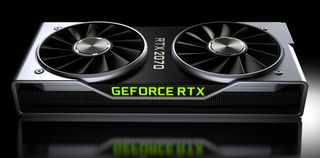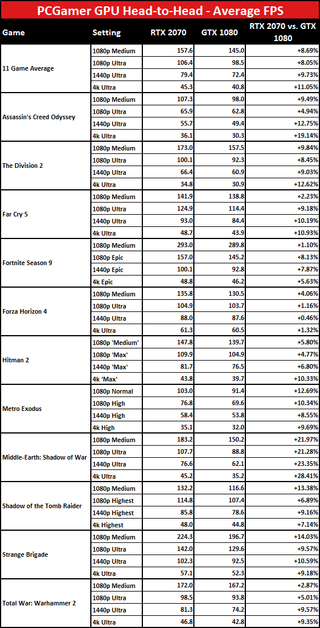GeForce RTX 2070 vs GTX 1080: Which graphics card should you buy?
Out with the old and in with the new.

Nvidia launched its Turing GPU architecture roughly a year ago, and since then has fleshed out its lineup with non-RTX variants that lack dedicated hardware for real-time ray tracing, and more recently refreshed its GeForce RTX series with upgraded Super models. This means you have more options to wade through in search of the best graphics card for your setup and budget.
Depending on how much you are looking to spend and what level of performance you are aiming for, you might be wondering if it's better to plunk down a wad of cash on a GeForce RTX 2070 (either the standard model or the Super variant) or a previous generation GeForce GTX 1080. All three launched with a $499 MSRP, putting these cards on seemingly equal footing. But are they really?
The quick and dirty answer is no, they are not, but of course things are more complicated than a simple 'yes' or 'no' response could convey. That is why we have decided to compare these GPU heavyweights, in terms of features, performance, and actual street pricing. After all, these are the things that ultimately matter when buying a graphics card (or any hardware component, really), in order to make an informed buying decision. So, let's get started.
Difference between RTX and GTX
Model names are sometimes meaningless, though that is not the case when comparing Nvidia's RTX and GTX nomenclatures. All RTX cards feature dedicated RT cores designed to muscle through real-time ray tracing chores. More recently, Nvidia updated its driver stack to also support real-time ray tracing on GTX cards from the current Turing crop and previous generation Pascal GPUs, but the lack of dedicated hardware makes it largely academic—simply put, if you are interested in enabling ray tracing in games, you should only be eyeballing an RTX card.
GeForce RTX cards also support something called deep learning super sampling (DLSS). In games that support DLSS, it is supposed to improve performance without degrading image quality. It does this by using high quality 64x sampled images to train a deep learning network. In theory, this should allow a game to render at a lower resolution, and then upscale and anti-alias the result in real time with images that look about the same as the native resolution with temporal AA. We've seen mixed results, though.
In our opinion, DLSS support is not sufficient reason alone to pick an RTX card over a GTX model, all other things being equal. Ray tracing support is arguably a bit more interesting (some may feel the opposite is true). The caveat with ray tracing is that it's still not widely employed, though the list of games is growing.
If you are wanting to enable ray tracing in games that support it, however, the RTX 2070 series is where things get interesting, particularly with the Super variant. The only cheaper options in the RTX family are the RTX 2060 Super and RTX 2060. The RTX 2070 Super and RTX 2070 are burlier cards with more muscle to throw at ray-traced workloads.
Let's get technical
Although there are a handful of GeForce GTX cards that are based on Nvidia's current generation Turing GPU, the GTX 1080 is not one of them—it features a previous generation Pascal GPU. Jarred posted a deep dive of the Turing architecture, in case you're curious about what all it brings to the table.
Architecture aside, here is a rundown of the specs of the RTX 2070 Super, 2070, and GTX 1080:
| Header Cell - Column 0 | GeForce RTX 2070 Super | GeForce RTX 2070 | GeForce GTX 1080 |
|---|---|---|---|
| Architecture | TU104 | TU106 | GP104 |
| Process | 12 | 12 | 16 |
| Transistors (billion) | 13.6 | 10.8 | 7.2 |
| Die size (mm^2) | 545 | 445 | 314 |
| SMs | 40 | 36 | 20 |
| CUDA cores | 2560 | 2304 | 2560 |
| Tensor cores | 320 | 288 | N/A |
| RT cores | 40 | 36 | N/A |
| Base clock (MHz) | 1605 | 1410 | 1607 |
| Boost clock (MHz) | 1770 | 1620 | 1733 |
| VRAM Speed (MT/s) | 14000 | 14000 | 10000 |
| VRAM (GB) | 8 | 8 | 8 |
| Bus width (bits) | 256 | 256 | 256 |
| ROPs | 64 | 64 | 64 |
| TMUs | 160 | 144 | 160 |
| GFLOPS (boost) | 9062 | 7465 | 8873 |
| Bandwidth (GB/s) | 448 | 448 | 320 |
| TDP (watts) | 215 | 185 | 180 |
The amount of memory (8GB) is the same across the board, though the RTX cards employ GDDR6 memory chips, while the GTX 1080 uses GDDRX5.
Looking at the clockspeeds, the GTX 1080 outpaces the RTX 2070, both in base and boost frequencies. It also has more CUDA cores. Nvidia addresses this with the RTX 2070 Super, which has nearly the same base clock and a faster boost clock, and matches the GTX 1080 in CUDA cores.
Don't get too caught up in all this, though. As we will see in a bit, the Turing architecture is stronger than Pascal, and performance shifts in favor of both RTX 2070 cards in most situations. This is ultimately what matters, so let's get right to it.
Performance
Jarred has run extensive benchmarks on these cards, and at a variety of resolutions and visual quality settings. How much faster is the key to this comparison, though, and whether it makes sense to stick with Pascal or bump up to Turing.

At 1080p, the difference in performance between an RTX 2070 and GTX 1080 is largely negligible. The 11 game average at medium settings shows the RTX 2070 being about 6 percent faster. That nudges up to around 8 percent when running games on ultra settings.

There is a bigger gap between the RTX 2070 Super and GTX 1080. It's closer to a 16 percent difference at medium settings, and around 17 percent on ultra settings. When you start getting into double-digit percentage differences, the gap in performance can matter, depending on the game (and in terms of longevity).
Similar trends can be observed at 1440p, but where the rubber meets the road is when looking at 4K performance. At ultra settings, the GTX 1080 averaged 40.8 fps (cumulative across 11 games), versus 45.3 fps for the RTX 2070 and 50 fps for the RTX 2070 Super.
None of these are ideal options for gaming at 4K, but the GTX 1080 is obviously the worst of the bunch, dipping to around 30 fps in some games. That is uncomfortably close to the line of being unplayable.
Price and value
Jarred noted in his review of the RTX 2070 Super that it is a great option for people looking to build a high-end gaming PC. Indeed, it places at the top of the charts for the FPS per unit of money spent on a complete PC, and the RTX 2070 is not far behind. Both cards are less enticing from a value standpoint when looking only at the graphics card, and not the cost of a system as a whole.
For this comparison, though, we're not evaluating the bang-for-buck proposition among all graphics cards. This is a showdown between the RTX 2070 cards and the previous generation GTX 1080. That's also what makes things tricky.
When the GTX 1080 launched, it was a $499 graphics card. And now? New models on Newegg cost upwards of $735, and several hover around the $1,000 mark. Yeah, no. We can say absolutely and emphatically that it makes zero sense to pay those kinds of prices for a GTX 1080. Zip. Zilch.
Pricing is far more reasonable on the second-hand market. Over on eBay, for example, you can expect to pay around $300—some go for a little less and others go for a bit more. Meanwhile, new RTX 2070 cards on Newegg typically go for $449 and up, and the RTX 2070 Super sells for $499 and up.
One thing to keep in mind, however, is that a used card might have been toiling away mining cryptocurrency 24 hours a day for a year or more. The GTX 1080 was a desirable GPU during the crypto craze, and a used card could have conceivably been run at full bore for long stretches.
Final word
What this really comes down to is if you are willing to chance a used (and potentially heavily used) GTX 1080. If you are, you can sometimes find them selling for less than $300. Compared to $449 and up for an RTX 2070 and $499 and up for an RTX 2070 Super, the value proposition is far higher. There's not enough separation in performance to warrant spending $150 to $200 more on a 2070 series card, and there are not enough games that support ray tracing to tip the scales, either.
Comparing used to new is sort of apples and oranges, though. Who knows how hard a used GTX 1080 has been driven, and because Nvidia and its hardware partners are phasing out Pascal, brand new models are mostly way overpriced.
Bottom line: unless you are comfortable with the risk of buying a used card, the RTX 2070 Super and RTX 2070 are better upper midrange (or lower high-end) options than the GTX 1080. The Super model is especially intriguing, as it offers close to RTX 2080 performance for less money.
The biggest gaming news, reviews and hardware deals
Keep up to date with the most important stories and the best deals, as picked by the PC Gamer team.
Paul has been playing PC games and raking his knuckles on computer hardware since the Commodore 64. He does not have any tattoos, but thinks it would be cool to get one that reads LOAD"*",8,1. In his off time, he rides motorcycles and wrestles alligators (only one of those is true).
Most Popular


